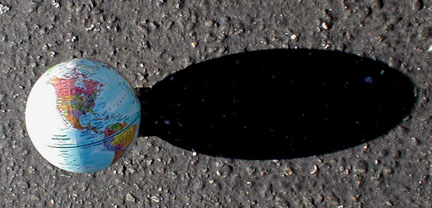Feel the Burn

View of a globe from above. San Francisco is top dead
center and the axis points north.
Feel the Burn

View of a globe from above. San Francisco is top dead
center and the axis points north.
Introduction
If you hold an earth globe outdoors in sunlight so that your position on the real earth is on top of the globe, and so the north of the globe points toward true north, then sunlight will fall on your globe exactly the same way that sunlight falls on the earth.
Material
Assembly
Go outside into direct sunlight. Place the bottle on the ground and place the earth globe onto the bottle. Rotate the earth globe until your city or location on earth is located at the top center of the globe. Keep your location at the top center and rotate the globe until the north pole of the globe points due north. (Use a compass to find true north, don't forget to correct the compass for magnetic deviation. See the Etc.)

To Do and Notice
Notice the areas of the globe that are in shadow. The same places on the earth are experiencing night. As the day progresses the shadow on your globe will change, so will the shadow on the real globe.
After ten minutes feel the temperatures of your globe. The point on the globe that is directly in line between the sun and the center of the globe (called the subsolar point) will be hottest. As you move away from the subsolar point the temperature of the surface of the globe will decrease. The same is true on the real earth. The subsolar point is always within 23.5 degrees of the equator where it is hot at noon, while the poles tend to be cooler, even when they are in the summer sun.
Notice that the night side of the earth globe, which is in shadow, is cooler than the day side which is in sun.
Notice that the polar regions feel cooler than the tropics. Sunlight hits the surface near the poles at a glancing angle.
Notice that in the northern hemisphere summer the arctic pole is in sunlight while the Antarctic pole is in shadow.
What's Going On?
The shadow on your globe is the same as the shadow of the earth because you have precisely lined up your globe and the earth. The axis of rotation of your globe is parallel to the axis of rotation of the earth.
Etc.
Place a short stick such as a toothpick at the top center of your globe. Notice the length of the shadow of the toothpick compared to the length of the toothpick. Now find a pole in the sunlight. Notice that the length of the shadow of the pole compared to the length of the pole is the same as the ratio of the shadow of your toothpick to the length of the toothpick.
Etc 2
The North Magnetic Pole is not located at the same place as the north geographic pole. Thus compasses do not point exactly to the north. Your local reference librarian should be able to tell you the magnetic deviation in your area. In general if you live west of Ohio your compass will point east of true north, while if you live east of Ohio your compass will point west. In California, your compass may point 20 degrees east of true north. There are websites which will give you the magnetic declination at your location. Look at http://www.noaa.gov.
|
Scientific Explorations with Linda Shore and Paul Doherty |
|
2 August 2001 |